Since then, little by little, the idea of buying a muscular family car has been gaining ground in my heart until I was determined to want one as soon as I became a parent. That time came this year, and the RS4 was the first choice. The problem? Well, my wife was going to drive the family car every day, and I was going to park it on the street, two conditions that, due to consumption and exclusivity of the device, did not fit with the adoption of the super Avant. When it's my turn to change my car, maybe the result will be different?
But beyond a monologue about personal garage problems, what am I doing talking about an Audi in USPI? Some people have the false perception that a server has "manifest package" to the Ingolstadt brand. We all know how easy it is to label people and classify them by those who prefer to stick to the superficial before digging into people's reasoning. No, I'm not a radicalist or a brand advocate. I am one of those who prefer to value products, not brands. I would never stop buying a car because it's a "x" brand, nor would I buy or recommend another one simply because it's a "Greek i" brand.
Audi, throughout its history, has had some real gems worthy of being considered jewels for those who enjoy driving. What happens is that they are small drops in an ocean of products designed as mere means of effective and efficient transportation, but without soul.
The RS4 B7 is probably the best demonstration of how Audi, quattro Gmbh, in fact, knows how to make cars that capture your soul. And now it can be yours for just over €25,000... So it's earned us this feature.
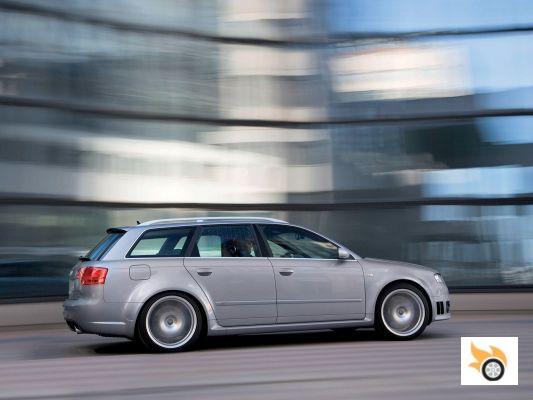
The idea of a performance but versatile and capable car for the whole family is the epitome for any parent driver.
The Audi A4, code B6, was born in 2001, but did not receive a "sporty" RS version until its redesign was launched, under code B7, in 2005.
The base model, mounted on the PL46 platform, was a longitudinal front-engine sedan longitudinally peeking in front of the front axle in full, with the gearbox in transaxle position on the front axle, and with the possibility of mounting all-wheel drive in versions "quattro" based on a central differential Torsen.
In terms of handling and manners, the A4 B6 and B7 (including the S4s of the time) were far from being "enthusiast cars". While they were tremendously fast and efficient thanks to the all-wheel drive and the available tuning, the problem was that the choice of spring rates, shock absorbers, stabilizers, silent blocks and so on made them more "safe to drive fast" than passionate.
So, on corner entry, if you weren't careful when cornering and you didn't reduce enough speed, you could quickly find yourself being dragged from the front. And having so much weight in front of the axle ended up taking its toll, having a rather compromised agility thanks to its, now famous, polar moment of inertia.
Therefore, when in 2006 we read that Audi had put more than 400 horsepower to the A4 we were displeased. Putting more power to the 4.2-liter V8 (in the S4 there were 344 horses, and now the RS4 was announced with 420) could be a good idea, after all there was plenty of power in the car, but we were not at all clear that the car was going to become overnight in an exciting toy. We were wrong.
A familiar but much improved proposition
The A4 B7's base was taken to a new level, especially with the V8 and interconnected suspension.
While the base was already well known, quattro Gmbh went a long way in proposing a version that was not only faster than an S4, but also sporty in feel and manner.
For starters, the V8 was a radical departure from the S4. In fact, it was the premiere of the engine that soon after would serve to power the Audi R8 production in its arrival on the market. It was an eight-cylinder openwork at 90 degrees, with cylinder head and block in aluminum alloy.
With 4,163 cubic centimeters of displacement, gasoline direct injection was used which allowed to bring the compression ratio up to 12.5:1, a very high figure. The design of the combustion chamber (four valves, instead of the five that Audi had been using to date) benefited from what was learned in the FSI engines at Le Mans to get burn gasoline as efficiently as possible without falling into unwanted detonations.
The valve train employed roller follower actuator fingers, hydraulic tappets, variable timing on intake and exhaust shafts, hollow-stem intake valves and sodium-filled exhaust valves. Forged pistons and connecting rods and a partitioned crankcase completed the configuration of an engine designed to be sporty from the outset.
In addition, all the accessories, with the exception of the alternator, are chain-driven, which serves to reduce the longitudinal size of the engine, creating an ultra-compact block, shorter than the original V8 of the S4, and almost as long as a normal A4 four-cylinder, which served to reduce the polar moment of inertia with respect to that S4, and prevent the RS4 from becoming a bigger car if possible.
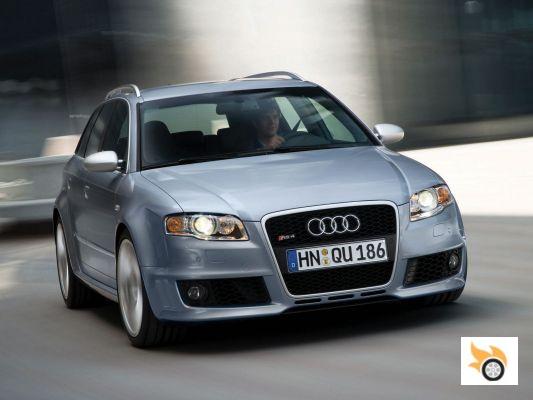
The direct-injection V8 pushes full of torque from 2,250 revs all the way to the cut-off at 8,250 rpm.
The V8 offered 420 horsepower at 8,000 rpm. It was capable of stretching all the way to 8,250 if necessary. Peak torque, astonishingly high for a naturally aspirated engine, was 430 Nm (over 100 Nm per litre of displacement), available at 5,500 rpm. But this was only part of the picture. As we explained here, the important thing about an engine is the shape of its torque curve, rather than the top end offered. In the RS4 90% of the torque was available between 2,250 and 7,650 revs, which ensured that the thrust was sensational from 2,250 revs all the way to the cut-off, and that's for a naturally aspirated engine.
The only gearbox available was a six-ratio manual, with a specially designed gearshift lever to shorten the travel between gear changes compared to other models of the house (always criticized for having to move the arm a lot).
The gearbox, signed by Getrag, was still almost completely sticking out in front of the front axle. Inside was an asymmetrical Torsen differential, which allowed sending 60% of torque to the rear axle and 40% to the front in normal driving conditions, being able to vary the distribution in a very radical way between axles. In addition, an integral differential locking system ensured that, in the case of complete loss of traction in one of the two axles, the car would not be left without traction (remember the case of the CR-V?).
The stability control could be switched off in two stages. In the first one, a more permissive setting was used and the traction control was switched off, which allowed drifting. In the second stage it was completely deactivated. The ABS also changed its setting according to the ESP phases. The power steering was operated by an electric pump hydraulic system that varied its flow according to two operating modes selected by a button with an "ese" on the steering wheel, which also served to modify the response of the electronic throttle between two maps.
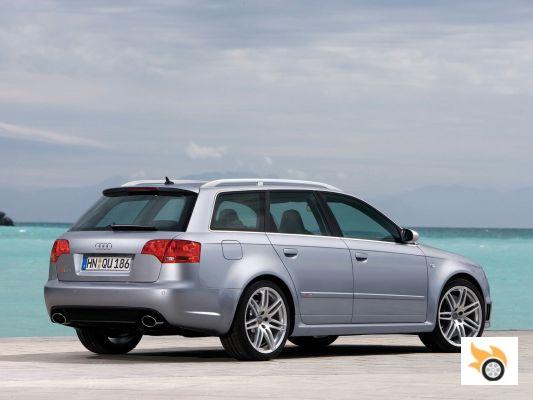
The chassis received a more than considerable extra track width: 37 millimetres at the front axle, 47 at the rear. The body was supported by double magnesium triangles (no less) in the front axle, with hollow stabilizer, while the rear axle used a system of five alloy arms with hollow stabilizer as well.
The standard wheels were 18-inch, with 19-inch rims as an option, hiding powerful 365-millimetre diameter floating disc brakes on an aluminium bellhousing, gripped by rigid calipers with four generous pistons. Carbon ceramic brakes were available as an option for the front axle, with an "endless" service life, lower weight and lower inertia, but due to their price as an option, few units can be found with them installed right now. NACA" air intakes in the underbody of the car serve to provide fresh air and ventilate the front brakes.
The suspension, as in the first RS6, sported a system of interconnected valves between the shock absorbers "in cross", similar to the patented "Creuat" system or that used by McLaren in the 12C, although somewhat less complex. On the RS4 the left front shock absorber was connected to the right rear shock absorber, and vice versa through active valves. Thanks to this system, the car reduced almost to zero the parasitic movements of pitch and roll at corner entry, one of the big drawbacks of cars with the engine hanging in front of the front axle. And it also achieved this without a noticeable decrease in comfort. The idea was that if the car pitched, the two front wheels would try to compress, while the rear wheels would extend. Thanks to the interconnected system, when one front wheel tried to compress, it would try to compress the opposite rear wheel at the same time. If the rear wheel was in extension, it would not let the front wheel compress because of the valve mechanism, thus stopping the tendency to pitch.
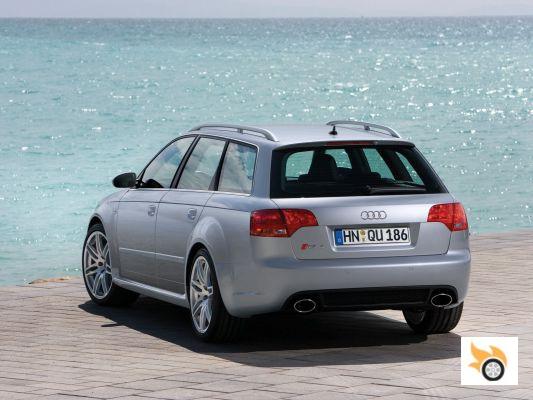
To cover the extra track width, Audi used more prominent aluminum front wings and widened the rear wheel arches. That serves as a starting point to evolve the entire aesthetics of the rest of the car, which uses different bumpers to conventional models, an aluminum hood and oval exhaust outlets at the rear. The satin aluminum mirrors supported on two thin beams are another differential wink in a car where "you can see and feel" that is "fat and powerful", but may go unnoticed to the untrained eye, which will capture that it is "a cool A4" but not quite know why he sees it so "macho".
An interior for the whole family
Open the door and you'll find yourself in front of an A4 of a lifetime. In our case, our preference goes to the Avant, as the convertible and sedan are not considered "so cool". An Audi RS has to be a five-door, you know. And if you have kids and a dog, like yours truly, you'll understand why, right?
So, on to the nitty-gritty. The A4 B7 trim was already scratching at great heights in 2006, so there's little we can say on this front. The differences from the "normal" versions start with the front seats, which are lighter semi- bucket seats that lack an integrated side airbag (supposedly, because of the shape of the petals, they're not necessary). The dashboard received genuine carbon fibre trim, while the steering wheel featured faux-aluminium steering wheel trim, which looked great in a photo, but in real life, being painted plastic, felt horrible to the touch. Carbon fiber trim was (and is) sold to eliminate that gray plastic from our view.
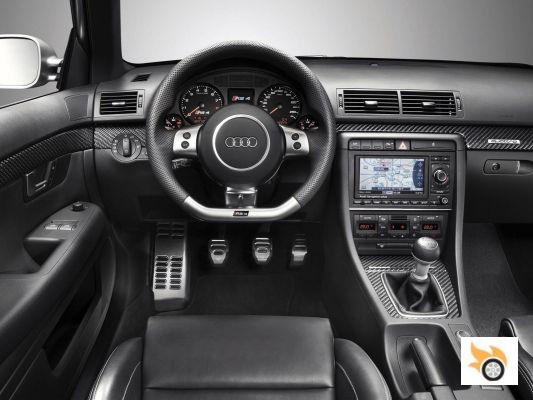
The front seats are spacious and comfortable. The steering wheel isn't too big, and the gear lever, thanks to its shortened travel, doesn't lag even when you're in second, fourth and sixth gear. The infotainment system was optional at the time, but the latest specification already featured a high-resolution sat nav and BlueTooth connectivity. The good thing about it is that with a little bit of know-how and money, you can install almost any VAG infotainment system of the time or a slightly more modern one.
The rear seats aren't the biggest in their class, nor were they at the time. Legroom suffers the most, being a relatively tight car in this regard, although things being what they are, the kids or two adults in the back won't find themselves overwhelmed either.
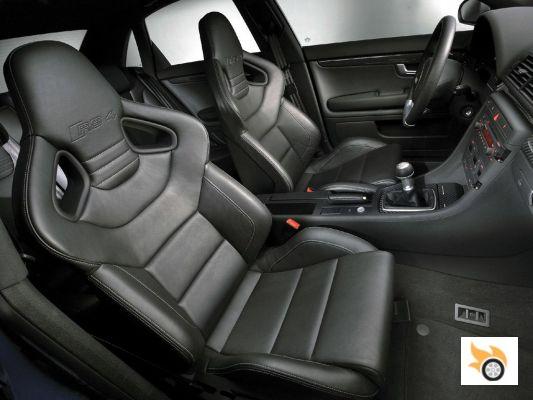
In the Avant variant, which is the protagonist of this special, you have a boot of 442 liters with the separator curtain deployed. The good news is that you have room to load up to the roof if you position the boot divider grille just behind the rear headrests, allowing you to fit large items through the large tailgate, or invite your dog in if you don't want him in the rear seats.
Unexpected fun
You open the door, insert the key, put it in the ignition position, and press a button to start the engine. Then a loud, naturally aspirated V8 like you can't remember anymore comes to life. It's harmonious, although it's not as present as in the current RS4 (which has two more years left, by the way).
Putting it in first gear is playing with a hard, but not exhausting lever, with a very marked travel and metallic feel. You release a hard clutch, and a caress of the gas puts you in motion. The engine is everything you want and expect from it. It's smooth, turns fine with no vibrations, sounds great, and to top it all off, it's full from very low to as high as you want to take it, with no bumps in the delivery, no holes or unexpected kicks.
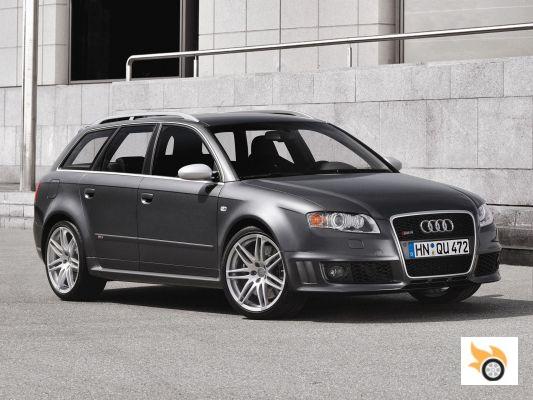
The kilometers through the city follow one another without any loss of comfort compared to other sedans of its size. It's a car that could well be worth to take the kids to school or go shopping, yes. If you go out to a highway or national highway, the power of the engine and the frank tread allow you to maintain cruises as illegal as you want. Overtaking is a very fast exercise (the car achieves 0-100 in 4.9 seconds, 0-200 in 16.6, a self-limited top speed of 250 km/h, and 80-120 in less than five seconds (4.8 timed by yours truly on his date).
If it's raining or snowing, if the tarmac is low on grip, few cars will be able to keep up with it, as its blend of traction capability and sheer power work wonders. And if you combine them with winter tires in the cold and wet seasons, you'll have a car to go to any meeting or trip, however complicated.
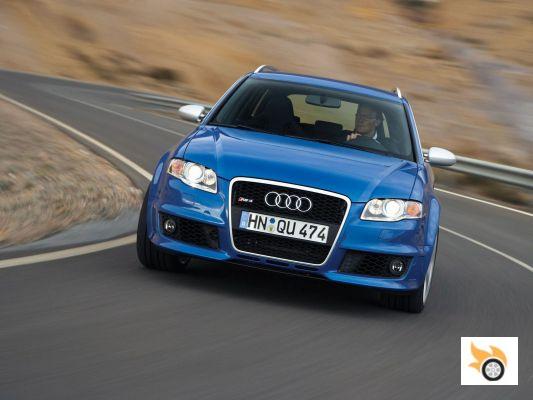
The amazing thing about this Audi is that it's alive in your hands, it makes you feel the road and lets you play with its attitude towards it.
But what's surprising, and what makes this car a strong candidate for this week's USPI, is the way it handles in curves. So much so that after reading and hearing wonders about this car in Automobile magazine first and in EVO later, I had to find a way to test it and see if it was "really" as good as they said it was.
On the straights and on the way to the first few fast corners, the RS4 is as quick and solid-footed as any current Audi. But when you bring your right foot to the centre pedal and execute the toe-tap two or three times to downshift, you can see there's something different here. For starters, the bottom bracket lets you play, and the shifter accepts the challenge, with perfect feel.
The car is lively and attentive to your demands. The nose barely pitches at all, leaving the wheels to work with plenty of suspension space available to take our first roll. If you're still on the brakes, the rear will make a slight attempt to hint, just enough for you to notice that the car isn't as big-headed as you first thought. If you overdo it with the entry speed, you'll obviously get a drag, but if you get the line right (or do the animal by going into the brakes and with your butt about to stick out), the RS4 will manage to turn almost flat, with almost no pitch, and with a direct and precise steering feel (although yes, it's still not the most sensitive steering wheel on the planet, but clearly better than current electric steering).
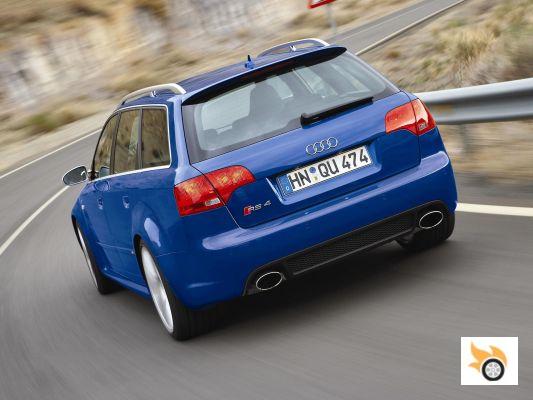
Once you're on your back, you can again play with the rear. If you go long, you can hollow out, and the nose sticks to the corner. Thanks to the supreme interlinked damper system, the car doesn't wobble with throttle loads applied, which shows the importance of having this device in this car. If you get close enough to see the exit of the corner, even if you haven't already bitten the apex, you can play with the right pedal, give the throttle violently, and the torque distribution will go far enough back to yaw the car in, as you make a measured counter-steer to look for the exit of the corner. With as much traction as this car has, it also manages to come out with a visceral kick in your kidneys that pulls you forward.

The suspension that works this miracle through interconnections (as it already happens with the current McLaren 650S), also allows to save travel and absorption capacity. In this way, if there are bumps in the middle of the support, the RS4 swallows them without flinching, with full confidence, and with full traction.
If you demand that the car gives everything it's got, the powerful brakes won't tire. In fact, you'll tire yourself out before the discs or calipers overheat.
Corner after corner, no matter how much the road gets bolder or slower and slower, the RS4 seems reluctant to show its front-engined Audi character, and it still doesn't get too overly heady, displaying a dynamic feel, letting you get a sense of how it mechanically grips the ground through your senses, allowing you to modulate the steering angle you're applying at every instant to feel at one with the machine and the road. Unexpected virtuosity, accompanied by a great eight-cylinder soundtrack.
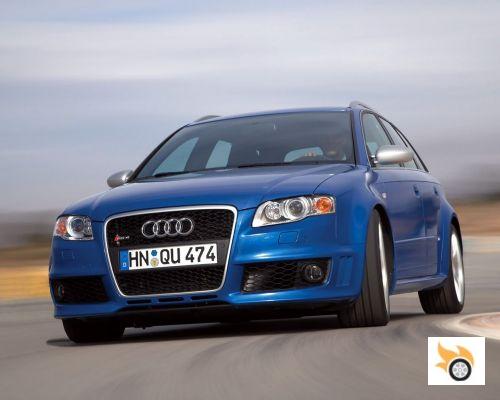
Surprisingly all this about way because, knowing and having tested so many and so many Audi, you can hardly count on the fingers of one hand those that feel so alive. Moreover, from the RS5 onwards, with the massive arrival of electronics to the piloted suspensions and steering and driving profiles, Audi (and quattro Gmbh) have changed that sensitive and mechanical RS4 for something much more digital, filtered, effective, yes, but also that disconnects the driver from the road, despite going faster if possible.
In that sense, R8 aside (another genius of its kind), the RS4 is the proof, perhaps the only proof, that at quattro Gmbh they know how to make cars that are genuinely designed for enthusiasts.
Problems and costs
But it's not all rosy. On Christmas Day I told you how the GT-R was a sweetheart, but was weighed down by its associated ownership costs. The RS4 has something similar, though not quite as pronounced.
Its main problem is called consumption. It drinks. It drinks a lot: 13.4 litres on average, it advertises. In reality it's easy to do 25 in town, 11 on the open road and... more than 25 in spirited driving. Conclusion? Either you have the money for 98 stock, or you don't get much mileage out of it... In either case, it'll hurt your pocket.
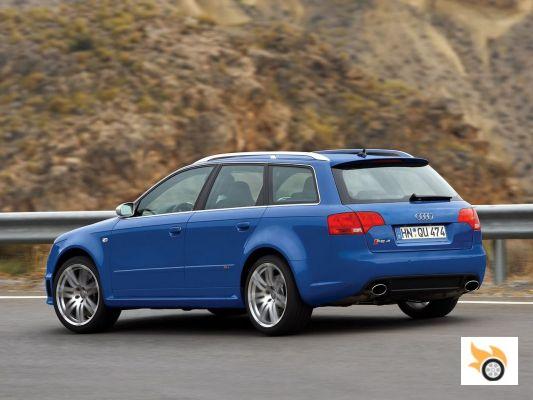
Otherwise, let's take a look at the fixed and variable costs, and things to check on the car, to give you a complete picture of the RS4.
Reliability and things to check
It's a solid car, the RS4, but it has, like all cars, its weaknesses. Let's go over them.
- Engine: These direct injection petrol engines have an unhealthy obsession with forming carbon deposits throughout their breathing and exhaust system. That's why every 70,000 kilometers, approximately, you have to make a carbon cure in a specialized workshop in the field (your nearest Audi workshop should know how to do it well). Without this treatment, the engine can run rough, spend more than necessary or not run as well as it should.
And watch out, no matter if the previous driver is a burnout, these deposits are formed equally (although in smaller amounts) even if you press the right pedal hard and stretch the revs.
If the car has 100,000 kilometers or more, it wouldn't hurt to find out and check that it has had that carbon treatment.
On the other hand, the first units delivered had problems in the original ECU mapping, with a rev rate at idle that was resolved in a maintenance campaign. The units you find should be cured of that problem.
Like many other high-revving, all-alloy naturally aspirated engines, the RS4's V8 drinks oil by design, in what we engineers call "top-end lubrication". The "problem" is that, as with the M3 E90 and E46, the car can drink a litre of oil every thousand kilometres if we "go hard". It is therefore advisable to check the level, but think that this does not have to be a problem. It is an engine designed this way.
- Transmission: The Gegrat gearbox is indestructible. The clutch tends to suffer quite a lot, due to the enormous torque it has to handle, but they usually last from 125,000 to 150,000 km if not more if the driver knows how to do it toe to toe.
- Chassis: This is where we find more problems. The DRC system of interconnected shock absorbers tends to fail due to leaks in the joints of the circuit. Since the RS4's behavior is so influenced by this system, you have to make sure that the unit you buy has it right.
Signs that it's not working properly are crackling noises during bumps in the shock absorber area (similar to the sound of a cupola failing). If this happens, fixing the shocks can cost up to £1,500 if you have to touch the seals on all four shocks.
In addition to this, the silent blocks and ball joints in the front suspension arms tend to deteriorate quickly, every 70,000 kilometres. Deterioration of the ball joints can be seen quickly in an MOT test, but it can also be heard with the steering wheel fully turned and moving around a car park slowly, when a "clunk-clunk" will flood the cabin.
The brakes hold a lot, but if you can find a unit with carbon-ceramic ones, all the better.
- Other: The first units had problems with the battery. Corrosion appeared in its housing, which is the place of the original A4's spare wheel in the trunk. There was a campaign to fix this, so all the units you see should be treated thoroughly. Aluminium bonnets and wings tend to dent more easily, check they're OK.
Otherwise, there's not much more to look at than the typical: badly repaired accidents (weird welds, bumpers that don't fit, rust that shouldn't be there...), chewed rims (the 19 especially), good alignment (uniform wheel wear), electronic failures that shouldn't be there (it's a very solid car, any error light should make you run away from the seller).
Ownership costs
- Insurance: A male driver with more than 10 years of driving license and with a clean accident record can pay about 1,200 euros at all risks with a small excess.
- Fuel consumption: Assuming a driver who drives around 25,000 kilometres per year, we would be talking about an average consumption of around 3,750 litres of 98 petrol per year. If we place it at a price of 1.30 euros per liter, we are talking about an average expenditure of 4,875 euros in gasoline annually (about 406 euros per month).
- Maintenance and consumables: Audi marks a fixed maintenance every 10,000 kilometers or one year, with oil and filter changes every 20,000 kilometers (editor's note: My data are from the British autodata, if you have different data from the Spanish market, please offer them in the comments). In any case, doing the basic maintenance can cost around 500€ per year for the basic service, and 700€ for the more in-depth "normal" service, doing oil and filters. Like all Audi, there are bigger revisions at 90,000 and 120,000 kilometers.
The consumption of tires and brakes is also quite important, due to the weight and power of the car. Tires can last you about 50,000 miles with "gentle" treatment. The typical 19″ mount is 255/35 R19 on all four wheels. Doing all four will cost you something like 1.100€, so if we divide the cost by two to assume that they will last you those 50.000 km, we can talk about 550€ per year to separate as a budget for tires.
As for the discs and pads, this is where you can get to suffer the most. And is that Audi comes to charge € 2,500 to make discs and pads to an RS4. Although it is normal that last about 75,000 kilometers (three years according to our distance account), we would be talking about € 830 in brakes to separate in the annual budget. Here it is especially important to assess the condition of the brakes of the unit you buy. Likewise, a trusted unofficial garage can fix the brakes for around 1,500€ without any major problem.
In total, road tax aside, driving 25,000 kilometers a year with an RS4 B7 will cost you about 8,155€, which translated into price per kilometer traveled would be 0.32€ per kilometer of use.
Conclusions
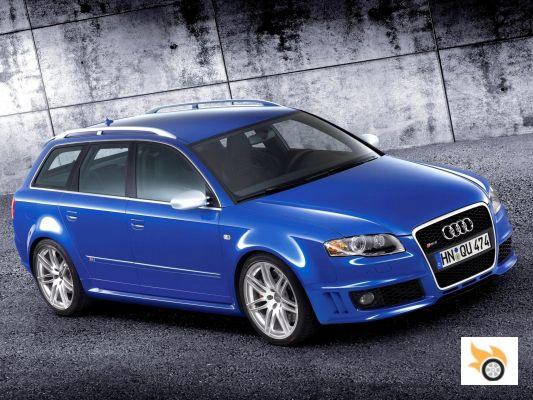
It doesn't exactly spend little, but with that aspect aside, I can't think of a better way to have a car for the whole family capable of being both fast and fun at the same time
The way it is: I like driving the M3 E90 better than the RS4 on equal footing. But BMW has its drawbacks: it doesn't have an estate body, and it doesn't have all-wheel drive. If, like me, you have a family, a dog, you live in an area where you see snow every year and you drive on it... Then a family car with four-wheel drive, besides being "cool", can be practical.
It's difficult to find a more interesting model than this RS4 B7. Dynamically, there is no other estate car that can match it. The new version of the RS4 is more aggressive and beautiful, but less interesting dynamically. An RS6 is too big and it's no fun either. Anyway, this market segment has one owner today, and it's this B7.
An Audi, yes. And it's recommended by Guille. So they'll say.

























